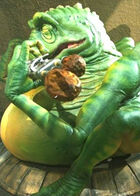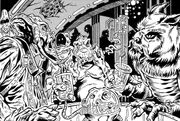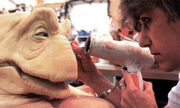| | |
Warning: The following parameters in the infobox are unrecognized: members
The Shawda Ubb, or Ubb, were a sentient species native to the planet Manpha in the Outer Rim Territories. They were small amphibians—each stood from 0.3 to one meter tall—with long arms and round, squat torsos. Their green and yellow skin was moist and elastic and covered in warts. Shawda Ubb were adapted to their moist, swampy homeworld, and felt physically weakened and emotionally withdrawn in dryer environments. They defended themselves by spitting a paralyzing venom, which was capable of immobilizing a Human-sized mammal for up to fifteen minutes. On Manpha, Shawda Ubb ate uncooked swamp plants and raw fish; they avoided cooked and processed food.
In their ancient history, the Shawda Ubb lived as marsh hunters. By the time of the Galactic Empire, however, most Shawda Ubb lived simple, low-technological lifestyles in small settlements, which were connected to one another via a network of transports and shuttles. Many of these towns and villages pumped crude petroleum from the swamps and sold it to oil companies located in Manpha's capital, Shanpan. There, the crude was processed into plastics for export from the planet's only spaceport. Other communities sold raw foods for export. Shawda Ubb were largely conservative creatures, and few left their home community. Leaving the planet was even rarer, although emigration was not unheard of. The Shawda Ubb musician Rapotwanalantonee Tivtotolon, better known as Rappertunie, joined the Max Rebo Band as a growdi player during the Galactic Civil War.
Biology and appearance
Shawda Ubb were comfortable with standard technology, such as datapads, but preferred simpler fare.
Shawda Ubb, also known as Ubb,[7] were diminutive, sentient amphibians with frog-like bodies. Members of the species had long, spindly limbs[1] that ended in three splayed digits each;[8] the toes also sported yellow claws. A bony shoulder blade jutted from the top of each arm.[3] The lanky appendages contrasted with the round, squat trunk typical of the species, with its prominent paunch,[4] navel, breasts, and nipples.[3] Generally, Shawda Ubb ranged in size from 0.3 to one meter in height.[2] Members of the species were covered in warty,[3] speckled skin that changed from a greenish-gray on the back, head, and limbs to a light yellow-green on the underbelly.[1] Some members of the species sported striped patterns on the forearms. A crest ran along the back of the head and down the neck and back, thickening as it traveled downward. Another thin crest ran along each forearm.[3]
The small, fat Shawda Ubb head[9] featured a blunt snout with a wide mouth and a thin lower lip. The two, side-mounted eyes were situated on the sides of the snout above heavy bags, and under heavy lids and thick brow ridges[3] that acted to keep rain from running into the Shawda Ubb's eyes.[8] Blue was one possible color for the irises of these visual organs.[3] Shawda Ubb were perceptive beings with a keen aptitude for observation.[5][10]
As per their amphibious nature, the Shawda Ubb thrived best in moist environments.[4] Their tough, elastic skin[1] was naturally damp,[11] but in dry environments, a Shawda Ubb had to keep his or her skin moist, lest it dry out and crack. In fact, extreme heat and dryness caused Shawda Ubb to tire quickly, making them lethargic[4] and preventing them from operating at their full capacity. Arid conditions also forced a Shawda Ubb to drink prodigious amounts of water.[12]
Although they lacked an imposing physique and ran at a relatively slow gait[5]—moving about half the speed of an average Human[10]—members of the species possessed a natural, acidic venom that they were able to employ as a defensive measure; a Shawda Ubb used the substance by spitting it on an attacker.[13] The venom had the ability to paralyze a Human-sized mammal for fifteen standard minutes.[4]
Shawda Ubb had two sexes, male and female. Despite their navels, members of the species hatched from eggs. Females laid between one and three eggs each year. Typically only one of these was fertilized to hatch into a child.[8]
Society and culture

The Shawda Ubb created several indigenous instruments, such as the growdi.
In their most ancient days, the Shawda Ubb lived as hunters, roaming the marshes of their homeworld, Manpha, and using their venom to paralyze prey and allow the pursuers to go in for the kill. As the species advanced technologically, they took to trading with one another and purchasing most of their food.[14] The species' diet consisted primarily of fish and marsh grasses; they preferred to eat their food raw.[5]
Shawda Ubb were suspicious of strangers and were willing to defend themselves with their paralytic venom if the need arose.[15] Accordingly, they preferred to live in settlements that were small enough to allow each inhabitant to recognize the other denizens. Such inclinations encouraged the founding and habitation of hundreds of thousands of small towns and villages interspersed throughout the marshes of their homeworld's lone landmass.[8] These settlements were often situated far from their nearest neighbor, which left their inhabitants reliant on visitors from afar to relate news of broader regional interest.[7] Although they generally eschewed travel,[12] Shawda Ubb employed a wide array of shuttles and transports to taxi themselves from one population center to another. Manpha had one spaceport, located in the capital city, Shanpan.[5] The city handled all interstellar trade and sported a bevy of bars and casinos to cater to off-worlders.[7]
Manpha possessed rich deposits of petroleum that constantly bubbled up into the waters of the planet's swamps.[15] The Shawda Ubb economy was based on small-scale petroleum extraction and refining; community oil cooperatives pumped fossil fuels from below the planetary surface and stored it in barrels to be sold to national oil companies headquartered in Shanpan. The factories, in turn, processed the oil to produce plastics for sale to off-world traders. Food processing was another important industry for the species; the Shawda Ubb preference for raw food prejudiced them toward selling uncooked victuals.[5] These enterprises provided a decent standard of living to most members of the species[12] and afforded the Shawda Ubb access to galactic-standard technology. Nevertheless, the species had little aptitude for tasks that involved piloting or technical equipment, and they preferred simpler goods.[16]
Shawda Ubb were known for their indigenous musical instruments. For instance, the growdi—also known as the growdi water organ[17] and the growdi harmonique[18]—resembled a combination of flute and water organ. A hose ran from the flute-like section to the base, upon which the player sat. The perch exuded moisture, which helped vivify the musician sitting there[6] and keep him or her cool.[19] The instrument came in both electronic and acoustic variants.[7]
Members of the species had two-part names, although their appellations were difficult for non–Shawda Ubb to pronounce. For this reason, they often took nicknames to use with aliens.[7] For example, the Shawda Ubb musician Rapotwanalantonee Tivtotolon was widely known as Rappertunie.[6]
History
The Shawda Ubb evolved on the humid, marshy world Manpha. Although they developed from avian stock, the species eventually became amphibious, adapted to the planet's wet ecosystem.[12] After developing sentience, early Shawda Ubb lived as subsistence hunters. Their technology eventually progressed to the point that they established small settlements and took to trading with one another instead.[14]
The Manpha system[20] became integrated into the greater galaxy at some point between 3000 and 1000 BBY.[21] The world was eventually reached by the Corellian Trade Spine hyperlane[22] and became part of the Seitia sector in the Outer Rim Territories.[20] The Shawda Ubb's homeworld was located outside both Galactic Republic and Separatist space during the Clone Wars,[23] but during the time of the Nagai invasion of the galaxy, the system was the site of a battle, which the Nagai invaders won.[24] Circa 25 ABY, Manpha lay within a region of the galaxy with an average population of ten to one hundred million sentients per star system.[25] In 137 ABY, the world fell within territory claimed by the Dark Lord of the Sith Darth Krayt as his Galactic Empire.[26]
Shawda Ubb in the galaxy

Although Shawda Ubb rarely left their home settlement, a few did roam the galaxy as musicians.
As unabashed homebodies, the Shawda Ubb rarely left their home settlements, let alone Manpha. Their small stature made members of the species vulnerable in a galaxy geared more toward larger beings, and Shawda Ubb were easy prey for predators on other planets.[7] Nevertheless, the species was not unknown in the wider galaxy; in fact, Dex's Diner, an eatery on the planet Coruscant, offered a Shawda Clubb sandwich on its menu.[27]
Rapotwanalantonee Tivtotolon was one of the rare Shawda Ubb who suffered from an unbridled urge to travel.[6] From his youth, he was a gifted musician who played several instruments,[28] and he wandered from settlement to settlement, playing instruments and spreading news to earn his keep.[7] The itinerate minstrel eventually set his sights on Shanpan, the planet's largest population center, and saved his money to afford transit to the spaceport city. He reached it after entering young adulthood.[12]
In Shanpan, Tivtotolon encountered off-worlders for the first time and adopted the stage name Rappertunie.[7] He played with a string of bands before he was finally discovered by a visiting musical group known as the Max Rebo Band. They invited Rappertunie to join them, and in the belief that being a member of their group would let him see the galaxy, the Shawda Ubb agreed.[12] Soon, Rappertunie found himself performing as a backup musician[28] for Rebo's group in the court of Jabba the Hutt on the desert planet Tatooine.[7] Rappertunie despised the gig; the world was hot and dry, and it involved little travel. The diminutive musician gained his freedom when Jabba's sail barge exploded during a skirmish—when Rebo and his lead singer, Sy Snootles, returned to the palace, Rappertunie rejoined them and left Tatooine.[12] Rappertunie and Snootles formed a duo for a time, but their efforts sold poorly. He eventually took up computer engineering for the droid-production company Rebaxan Columni as part of the team responsible for the design of upgrades for the MSE-6 series.[18]
Behind the scenes

Rappertunie the Shawda Ubb was a full-size puppet created for the Special Edition of Return of the Jedi.
A frog-like puppet was created as part of the changes to the Special Edition of the Star Wars: Episode VI Return of the Jedi film during its 1997 re-release. Concept art for the character was drawn by George Hull; an early design resembles the final creature except for its long tail, which was removed from the final puppet.[29] The crew referred to the character as "Jedi Rapper" during production. The puppet was digitally added to scenes of the Max Rebo Band performing in Jabba's Palace as part of a general change to replace the older song, "Lapti Nek", with a song called "Jedi Rocks."[11] As part of Jabba's court, Rappertunie appears as a background character in several images of the palace, as in Escape from Jabba's Palace, a children's book written by Jay Rudko.
Both the musician character and his species received names—Rappertunie and Shawda Ubb, respectively—in the Star Wars Trilogy Sourcebook, Special Edition, a 1997 sourcebook for Star Wars: The Roleplaying Game published by West End Games. The volume's writers also provided information about Shawda Ubb biology, culture, and society. Game statistics in the book allow players of the roleplaying game to portray Shawda Ubb characters; they receive bonuses to actions taken in moist environments, but penalties to those in dry ones.[14] The 1998 West End Games book Alien Encounters reprints these values and expands on the species' background.[16]
Appearances
 Dining at Dex's on Hyperspace (article) (content removed from StarWars.com and unavailable) (Indirect mention only)
Dining at Dex's on Hyperspace (article) (content removed from StarWars.com and unavailable) (Indirect mention only)- Star Wars: Episode VI Return of the Jedi (First appearance) (post-1997 releases)
- Star Wars Episode VI: Return of the Jedi junior novelization
- Escape from Jabba's Palace
